Dating in the digital age can feel like navigating a maze constructed of glowing screens and ambiguous notifications. For those of us who remember a time when courtship unfolded with more directness, this new landscape is both fascinating and, at times, profoundly bewildering. The once straightforward cues of attraction have been replaced by a complex web of emojis, delayed responses, and messages that often leave you wondering if you’re fluent in an entirely new dialect.
I recall the days when meeting someone involved a shared glance across a room, a smile, and perhaps an exchange of phone numbers scribbled on a napkin (Yes, I’m sharing my age). Conversations were organic, flowing from shared laughter or a serendipitous common interest. Intentions, while not always announced immediately, were often clearer, allowing for a natural progression of connection. Now, interactions frequently begin with a swipe to the left or right, and are punctuated by emojis whose meanings can be as varied as the people using them, or the mood in which they’re received.
Emojis have, in many ways, become the new language of affection, sarcasm, playful teasing, and everything in between. They’re digital symbols attempting to convey the nuances of human emotion. A compelling study by Dubé et al. (2024), published in the Journal of Digital Communication, found that individuals with higher emotional intelligence tend to use emojis more frequently in their digital communications. This suggests that these seemingly simple symbols play a significant role in conveying emotions online, acting as a shortcut to expressing what words alone might miss. The study notes, “For emotionally intelligent individuals, emojis serve as effective tools for emotional regulation and expression in digital interactions, bridging the gap between digital text and genuine sentiment.”
However, the use of emojis isn’t always straightforward, leading to a sort of digital ‘gaslighting’ where your own interpretation battles against a perceived, yet unstated, reality. The same Dubé et al. (2024) study noted a crucial nuance: those with avoidant attachment styles, individuals who prioritize independence and often feel uncomfortable with deep intimacy, tend to use fewer emojis. This can potentially lead to significant misinterpretations in digital conversations, where a lack of emotional cues might be perceived as disinterest rather than a communication preference rooted in attachment patterns. This presents a constant challenge for someone like me, who isn’t accustomed to constant digital communication or deciphering the subtle language of a single thumbs-up emoji. I often find myself uncertain about the appropriate use of emojis, or the expected response time to messages. The pressure to maintain a certain online persona, coupled with the ever-present fear of miscommunication, can be genuinely overwhelming.
Moreover, the impersonal nature of online dating platforms can be disheartening. Instead of genuine conversations that unfold organically, interactions often feel transactional, like sifting through a catalog of potential partners. The anonymity provided by screens sometimes emboldens individuals to use language and exhibit behaviors they might avoid in face-to-face interactions. This shift in communication dynamics can make the dating experience feel less respectful and more objectifying, reducing individuals to a set of curated photos and a handful of bullet points.
Research indicates that the design of online dating platforms can contribute to this objectification. A comprehensive systematic review by Orosz et al. (2020), published in Computers in Human Behavior, highlighted that certain personality traits, such as sensation-seeking and sexual permissiveness, are associated with greater use of online dating services. This correlation potentially leads to more superficial interactions, where the focus shifts from genuine connection to immediate gratification or validation. As the authors articulate, “The gamified nature and profile-centric interface of many dating apps can inadvertently foster a mindset of consumption rather than connection, impacting the quality of interactions.”
The pressure to maintain a certain online persona, coupled with the fear of miscommunication, can be overwhelming. As actress Anne Hathaway once reflected on the demands of public life to The Guardian in 2018, “I used to be very, very careful about every single thing I said. And it was exhausting.” This sentiment resonates deeply with the digital dating experience, where every message can feel like a performance, draining the energy required for genuine connection. Similarly, her insight that “If you’re not someone who has a natural and effortless love for yourself, it’s hard to let go of your desire to please other people, and that’s really not an ingredient for a happy life” underscores the internal struggle with validation that can be exacerbated by transactional online dating.
Despite these challenges, it’s essential to recognize the potential for growth and adaptation within this evolving landscape. Embracing the digital age doesn’t mean abandoning one’s core values or sense of self; rather, it means finding ways to integrate them into new modes of communication. For instance, using emojis thoughtfully, with a clear understanding of your own emotional intent and consideration for the receiver, can genuinely enhance messages, adding meaning and emotion that text alone might lack. It’s about leveraging the tools without letting them define the interaction. As Grammy-winning artist John Legend so eloquently states, “Soul is about authenticity. Soul is about finding the things in your life that are real and pure.” This powerful perspective reminds us that true connection, regardless of the platform, always stems from a place of genuine self.
Furthermore, being open to learning and adapting can lead to more meaningful connections. While the medium has undeniably changed, the core of human interaction, including empathy, respect, active listening, and genuine interest, remains constant. As John Legend further emphasizes, “I think the thing about love is that even though the things around us change, we as human beings, a lot of the ways we interact, and the ways we love each other is timeless. It requires trust, honesty, commitment, romance, and physical chemistry.” By focusing on these elements and prioritizing authentic conversation over digital performance, it’s possible to navigate the complexities of modern dating with authenticity and a sense of purpose. It’s about being deliberate in your digital communications, setting boundaries, and not being afraid to pivot to face-to-face interactions when the timing is right.
Traditional values with modern tools can lead to enriching and fulfilling experiences. It’s about finding balance, staying true to oneself, and being open to the possibilities of change rather than being swept away by the current. Remember: Behind every screen is a human being, just as complex and yearning for connection as you are.



